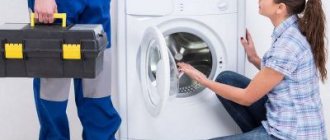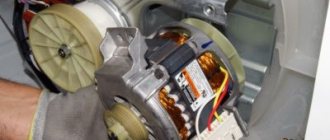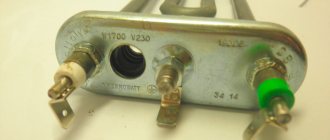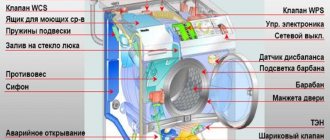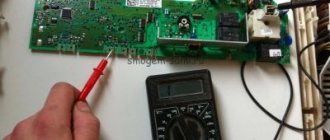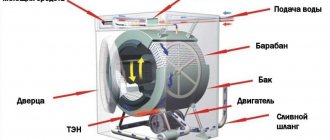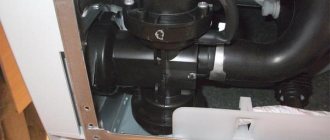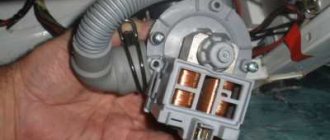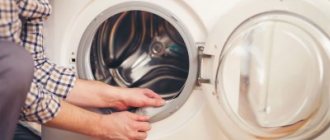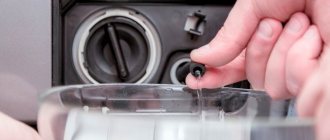The device responsible for the correct closing of the hatch and the tightness of the drum during the washing process is called UBL (hatch blocking device).
Hatch locking device
Its design includes a thermoelectric element and a bimetallic plate that physically block the door section in the washing machine body until the end of the wash. Knowing the design of the locking mechanism, you can detect signs of its imminent breakdown in time and replace the sensor without waiting for a more serious reason for repair. The design is similar for most automatic washing machines: LG, Atlant, Samsung, AEG.
Where is UBL located?
The control mechanism for opening and locking the washing machine door is located in the hatch lock housing, on the front panel. Directly in the place where the hatch hook fits. It is enclosed in a plastic case and equipped with a power connector.
Removing the
The thermoelectric sensor for closing the door of a washing machine is a horizontal plate in the center of the lock structure, on the one hand, limited in mobility, and on the other, equipped with a pressing spring. Under the plate there is a thermistor, which expands from the current passing through it and pushes the plate sideways.
UBL models Bosch
To make a replacement on a Bosch machine, you need to perform the above manipulations. The UBL can be easily replaced at home using two simple tools and a little skill. The design and components of the Bosch machine do not differ in any non-standard devices, so the new UBL easily replaces the old lock.
Call the master
All actions must be carried out extremely carefully so as not to damage the clamp of the Bosch washing machine. Otherwise, you just need to adhere to the specified scheme for replacing the UBL.
How does it work
The function of the sensor responsible for closing the hatch is to prevent the lock from disengaging before the program ends.
Basic design of the lock
As soon as the hatch of a working Samsung, LG or other company washing machine is closed and the washing program has been entered, the following processes occur:
- The control current passes through the thermistor, and it expands, heating up.
- The thermistor pushes the bimetallic plate, it bends and presses on the pin.
- The pin fits into the groove of the lock and secures the hatch hook.
Sensor device
The washing machine door sensor is energized the entire time the program is running. When it turns off, the thermistor cools down and the plate releases the hook.
Procedure for repairing/replacing the lock on the door body
What we do during renovation work at a client’s home.
- Disconnect the washing machine from the network. For safety reasons, be sure to turn off the power to the washing machine.
- We remove the door from the car. To do this, unscrew the screws that secure the door to the SM body.
- Let's disassemble the door. The mechanism is located inside the door body. To disassemble the door we perform five steps:
- dismantle the hinge on which the door is attached to the car (on some models it can not be removed, it does not interfere with disassembly);
- Unscrew the screws holding the outer and inner halves of the hatch body;
- carefully press out the latches that secure the parts;
- we separate the halves of the hatch body;
- remove the outer part and take out the glass.
- Inspecting the inner half and the lock. We have gained access to half of the door body with a handle and a mechanical lock and can inspect them to understand whether the machine lock will need to be repaired or replaced. Based on experience, inspection reveals three main lock faults:
- the plastic tongue or hook is damaged - the main part that connects the door to the UBL;
- the metal rod has fallen out of the groove, so the tongue has shifted and does not fit into the hole of the locking device;
- The mechanical plastic groove (fastening) of the rod broke.
- We remove the handle and disassemble the lock. Everything is together - the handle and the mechanism parts are attached to one pin, we pry it up with a screwdriver and move it to the side, then pull it out completely. If the latch (lock tongue) is broken, install a new one. If a pin falls out on one side, put it back in place. Sometimes the pin falls out because the plastic groove is broken. In rare cases, it can be “fixed,” but more often than not, you have to replace the entire door. Or, if you’re lucky enough to find it, we change the inside of the hatch body.
- We assemble the door and mount it on the body. When the lock is in order, you need to assemble the car hatch and install it in place. First we place the glass in the groove of the inner part. Then we put the outer part on top and snap the halves together. We tighten the fastening screws into place and screw the hinge onto the door (if you removed it). Then we install and secure the door to the body of the machine.
- Let's check the lock. Turn on the washing machine, select any wash mode, for example, quick. Press the “start” button and see if the washing machine turns on. If it starts, it means the lock is working correctly and locking the door.
Note! Sometimes the lock is fine and the door does not close due to skewed hinges or for another reason. Then the door itself needs to be repaired. Read more about this in the article Repairing the door (hatch) of a washing machine.
Malfunctions
If the hatch of a Samsung, Atlant, AEG, LG washing machine or another automatic machine in which a thermoelectric sensor is installed remains blocked after the end of the wash, then one of the situations occurs:
- the thermoelectric relay has not yet cooled down (you need to wait a few minutes);
- the machine did not consider the program completed (you need to restart the program by setting “spin” or “rinse” again, the unit needs to be checked);
- the bimetallic plate is out of order and physically blocks access (you need to open the hatch in “emergency mode”).
Fault error code
If the door sensor of the Samsung washing machine is faulty - the hatch did not close completely or the mechanism itself with the thermistor has failed, one of the letter error codes will be displayed on the display:
- DE (DE 1; DE 2);
- DC (DC 1; DC 2);
Checking the lock
Often, some time after using the washing machine, a situation may arise when a UBL check is required. It may jam and even after a long time at the end of the wash may not open, or a characteristic opening click will occur, but the lock will not open. In this case, it may be necessary to replace the UBL of the washing machine.
UBL repair
However, first you need to check. To check the UBL of a washing machine, you need to perform a number of manipulations:
- open the hatch of the washing machine and find a thin wire in the rubberized space, carefully pick it up and remove it;
- after that, find the lock under the elastic band and carefully unscrew the fasteners;
- disconnect the unit and remove the plug securing it;
To check the functionality of the UBL, you need a multimeter with a wide range and a circuit diagram for a specific brand of washing machine. The thing is that the nodes and connections in different models are located completely differently.
Where is UBL located?
To check the lock, the following scheme is performed:
- set the device to resistance testing mode;
- connect the first probe to the neutral contact, and the second to the phase contact;
- replacing the lock is not required if the multimeter displays a three-digit number;
- connect the first probe to the neutral contact, and the second to the common;
- The UBL is inoperative if the device shows zero or one.
If the multimeter shows a result that indicates that the lock is not working, the washing machine UBL may need to be repaired.
Serviceman
Why do breakdowns happen?
The two main reasons for breakdowns of the door close sensor on washing machines are mechanical wear of the bimetallic plate and the loss of the thermal relay of its properties due to a sharp surge in voltage in the network (up). In both cases, the device requires repair and replacement of parts. The owner can check the properties of the relay using a household tester independently.
If the “lock” icon flashes on the machine’s dashboard, this does not always indicate a problem with the door locking. There are several similar situations:
- On some models of Atlant and Samsung machines, this may indicate a problem with the pressure switch and the correct water level in the drum.
- Sometimes Samsung cars give a flashing door indicator if there are problems with the heating element. In this case, the device requires qualified diagnostics and repair.
- On some models of LG washing machines equipped with a “child lock” function, the hatch lock is activated and released only by pressing certain buttons. Before calling a technician, you should check and rule out the “standard” closing of the hatch.
Thus, some breakdowns of the door close sensor can be corrected yourself.
Procedure for repairing/replacing UBL
During renovation work at a client’s home, we perform the following work:
Washing machine lock repair
A hatch locking device (HDU) is available in all modern automatic washing machines. It is also called a blocker or simply a lock .
Washing machine locks operating on the basis of a bimetallic plate are thermal locks , and on electromagnets - electric locks.
The vast majority of washing machines produced today have thermal locks installed. They are distinguished by reliability and long service life. But even these durable mechanisms often fail.
Operating principle of UBL
The hatch blocking device is small in size, mounted on the inside on the front wall of the washing machine.
The main element of the thermal lock is a bimetallic plate . Heating it ensures the lock is locked, and cooling it unlocks it. Due to temperature changes, the plate changes its size and position twice during one wash cycle: at the beginning, when the door is locked, and at the end, when it is unlocked.
After years of active use of the washing unit, the bimetallic plate is destroyed - the UBL breaks.
The plate is heated by applying voltage to a thermoelement located next to it. After the current supply is stopped, the plate cools down. This process takes a few minutes. That is why the hatch door unlocks not immediately after the end of the wash cycle, but a little later.
If the power is turned off while the washing machine is operating, the UBL bimetallic plate will cool down in a couple of minutes, unlock the lock, and the owner of the unit will be able to open the hatch door.


